5/ 5/ Curious about real-world performance gains from modern web APIs?
Navigation AI leverages the Speculation Rules API to predict user behavior and speed up navigation.
#WebDevelopment #CoreWebVitals #PerformanceOptimization #AI
30.01.2025 22:18 — 👍 1 🔁 0 💬 0 📌 0
4/ 🔑 Next Steps:
1️⃣ Evaluate if SPAs are still the best fit for your site.
2️⃣ Leverage View Transitions for smooth, app-like experiences in MPAs.
3️⃣ Explore Speculation Rules to preload and optimize navigation.
30.01.2025 22:18 — 👍 0 🔁 0 💬 1 📌 0
3/ Speculation Rules API, another modern browser feature, preloads content based on predicted user actions, speeding up navigation and improving performance. 🚀
30.01.2025 22:18 — 👍 0 🔁 0 💬 1 📌 0
2/ With browser APIs like View Transitions, MPAs can now deliver app-like navigation with minimal overhead. 🖥️✨
30.01.2025 22:18 — 👍 0 🔁 0 💬 1 📌 0
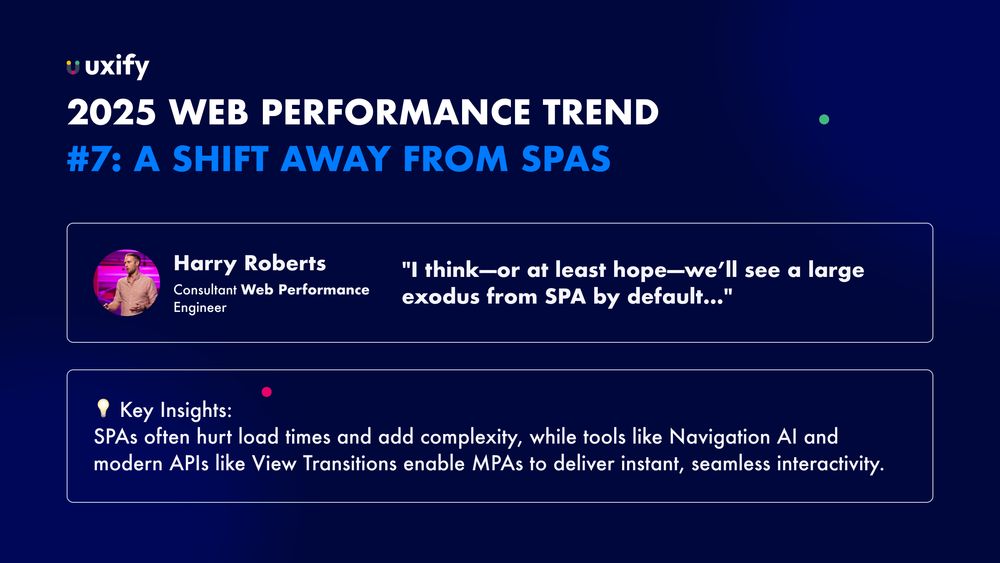
1/ Are SPAs still the best choice for your site?
@csswizardry.com predicts a shift away from SPAs in 2025, as modern browser APIs like View Transitions and Speculation Rules make MPAs a more efficient choice for fast, smooth browsing. 🧵👇
#WebPerf #SPAs #MPAs #SpeculationRules
30.01.2025 22:18 — 👍 1 🔁 0 💬 1 📌 0
If you're using CloudFront, you're on the right track! CloudFront supports Brotli, but you may need to configure it in your settings to take full advantage of compression dictionaries. It's best to checkout their documentation. You can start here: github.com/pmeenan/comp...
30.01.2025 09:55 — 👍 1 🔁 0 💬 0 📌 0
Great question! Compression dictionaries work at the server/CDN layer, where data is compressed before sending to the client. Ensure your CDN/host supports modern methods like Brotli/Zstandard for efficient implementation. Let us know if you need more info!
30.01.2025 08:37 — 👍 0 🔁 0 💬 1 📌 0
5/ Are you using compression dictionaries yet? If not, it’s time to optimize how you’re delivering content. #CoreWebVitals #Compression #PerformanceOptimization #TechInsights
29.01.2025 22:18 — 👍 0 🔁 0 💬 0 📌 0
4/ ✅ Implementing compression dictionaries:
1️⃣ Verify dictionary-based compression support with your CDN or hosting provider.
2️⃣ Target reusable assets like templates, headers, and menus for optimization.
3️⃣ Use Brotli or Zstandard for more efficient compression.
29.01.2025 22:18 — 👍 0 🔁 0 💬 1 📌 0
3/ The results? Significantly improved load times, particularly for sites with frequent content repetition. This is key for mobile traffic and sites with high repeat visitors where milliseconds matter.
29.01.2025 22:18 — 👍 0 🔁 0 💬 1 📌 0
2/ Compression dictionaries work by reducing redundant data transfers. Common assets like headers, footers, or menus are stored once and reused, while only unique data is transmitted. It’s a smarter, more efficient way to handle repetitive content across your site.
29.01.2025 22:18 — 👍 0 🔁 0 💬 1 📌 0
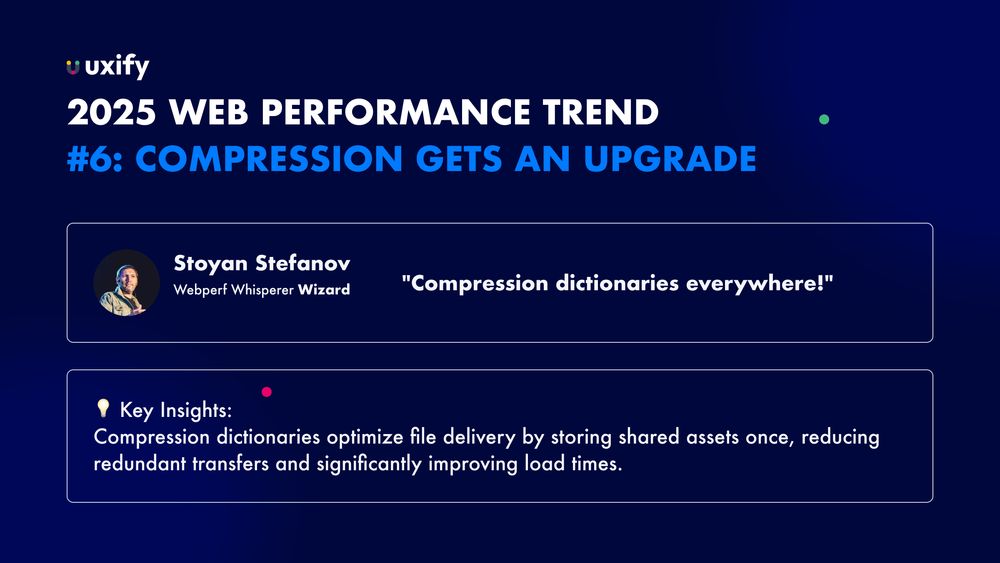
1/ Is compression about to get a major upgrade?
@stoyan.me predicts "compression dictionaries everywhere" by 2025. By storing common elements once and sending only the unique parts, we can drastically reduce transfer times. Will you be integrating this? #WebPerf #Compression 🧵👇
29.01.2025 22:18 — 👍 5 🔁 2 💬 2 📌 0
5/ Question for the Community:
How are you optimizing AI-driven chat features to ensure they enhance UX without sacrificing site speed? #WebPerf #AIChat #CoreWebVitals #PerformanceEngineering
28.01.2025 22:18 — 👍 0 🔁 0 💬 0 📌 0
4/ Optimization Tip: Use tools like Chrome's Performance Panel and RUM to analyze how chat tools affect Core Web Vitals. Ensure your AI engagement doesn't come at the cost of performance.
28.01.2025 22:18 — 👍 1 🔁 0 💬 1 📌 0
3/ 💡 Key Strategies for Optimizing Chat Tools:
1️⃣ Lazy-load AI chat scripts to avoid blocking critical resources and slowdowns.
2️⃣ Monitor the impact of chat tools on load times and responsiveness in real time.
3️⃣ Conduct regular performance audits and fine-tune chat systems for efficiency.
28.01.2025 22:18 — 👍 0 🔁 0 💬 1 📌 0
2/ AI chat tools can severely impact performance if not optimized properly. Poorly implemented scripts can introduce bloated code, slow load times, and hinder overall responsiveness. A site that feels slow on interactions will frustrate users and hurt engagement.
28.01.2025 22:18 — 👍 0 🔁 0 💬 1 📌 0
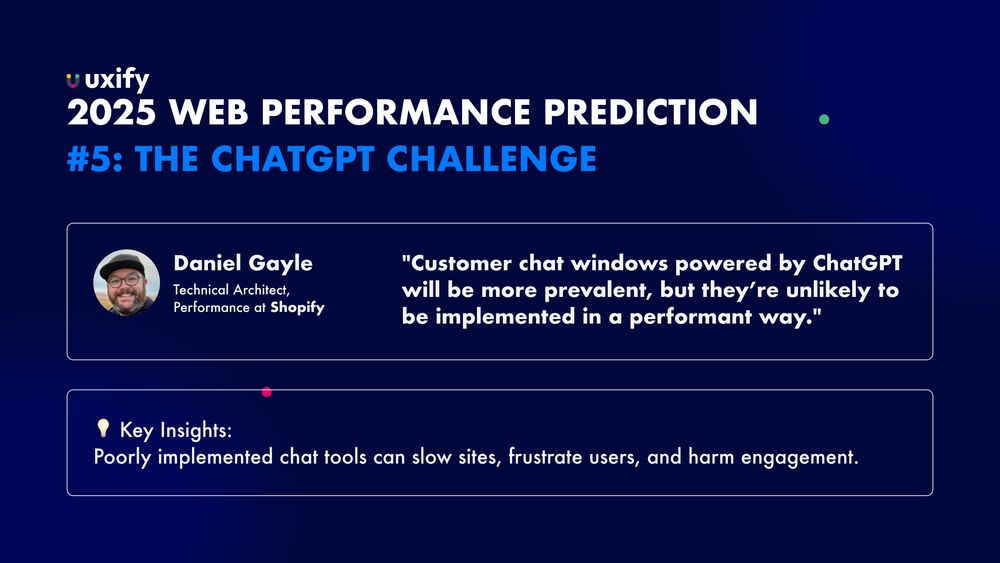
1/ 🚀 2025 Web Performance Prediction 5: The ChatGPT Challenge
"Customer chat windows powered by ChatGPT will be more prevalent, but they’re unlikely to be implemented in a performant way." – Daniel Gayle, Technical Architect, Performance at Shopify 🧵👇
28.01.2025 22:18 — 👍 1 🔁 0 💬 1 📌 0

2025 Web Performance Trends: Expert Predictions and Business Takeaways
Discover expert predictions for web performance in 2025, including INP optimization, AI tools, and new browser technologies. Learn how businesses can adapt and thrive with actionable insights and…
6/ How are you leveraging AI in your performance strategy for 2025?
Read more: https://buff.ly/40x2r2H
#WebPerformance #AI #CoreWebVitals #RUM #NavigationAI #WebDev #AIinWebDev #ChromeDevTools #AIforWeb #SpeedOptimization #TechTrends #2025Predictions
23.01.2025 22:18 — 👍 0 🔁 0 💬 0 📌 0
5/ ✅ Next Steps for 2025:
Implement predictive tools like Navigation AI for preloading based on behavior patterns.
Utilize AI diagnostics to automatically identify and resolve slow scripts.
Optimize Core Web Vitals with AI-driven insights for faster, smoother interactions
23.01.2025 22:18 — 👍 0 🔁 0 💬 1 📌 0
4/ 🚨 RUM AI:
Real User Monitoring powered by AI detects performance dips and potential regressions before they affect users, enabling teams to fix issues proactively.
23.01.2025 22:18 — 👍 0 🔁 0 💬 1 📌 0
3/ 🔧 Chrome’s AI Diagnostics:
AI now helps identify bottlenecks in scripts and critical resources in real-time, providing actionable fixes that speed up rendering and reduce input delays.
23.01.2025 22:18 — 👍 0 🔁 0 💬 1 📌 0
2/ 💡 AI-powered Predictive Preloading
AI-driven tools like Uxify's Navigation AI predict user behavior, preloading subsequent pages and reduce latency
23.01.2025 22:18 — 👍 0 🔁 0 💬 1 📌 0
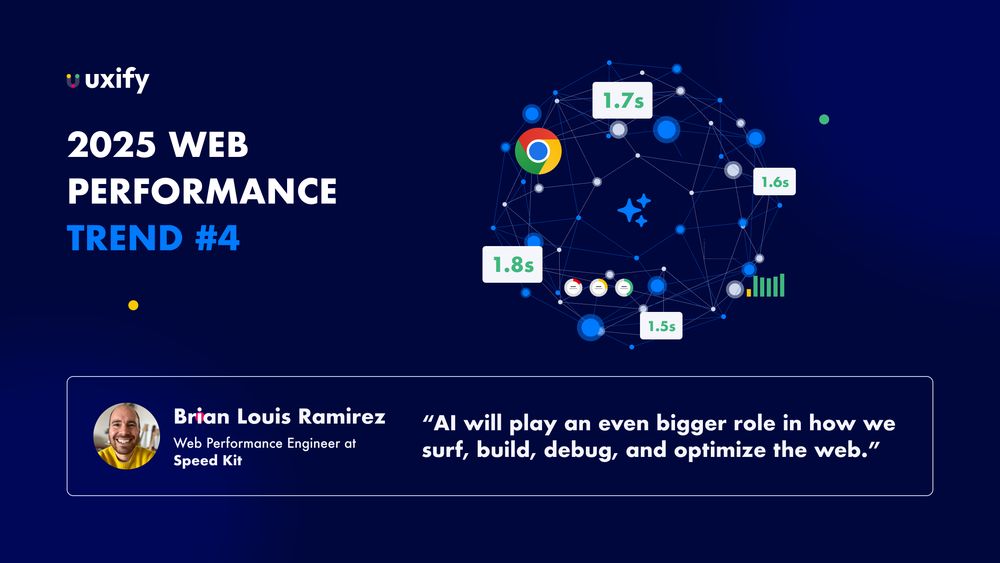
1/ 🚀 Prediction 4: AI Takes Over Performance Optimization
@screenspan.net predicts "AI will play an even bigger role in how we surf, build, debug, and optimize the web"
Let’s dive into the key insights for 2025. 🧵👇
23.01.2025 22:18 — 👍 1 🔁 1 💬 1 📌 0

2025 Web Performance Trends: Expert Predictions and Business Takeaways
Discover expert predictions for web performance in 2025, including INP optimization, AI tools, and new browser technologies. Learn how businesses can adapt and thrive with actionable insights and…
Next Steps for 2025:
✅ Adopt cross-browser tools like the PerformanceEventTiming polyfill.
✅ Optimize for Safari and iOS by reducing JavaScript delays and improving interactivity.
Get all 2025 web performance trends here: https://buff.ly/40x2r2H
#WebPerf #CoreWebVitals #INP #SafariPerformance
21.01.2025 22:18 — 👍 0 🔁 0 💬 0 📌 0

How to measure INP on Safari with Uxify
Learn about Ivailo Hristov's solution for improving INP measurement, making web performance insights more accessible across all browsers and devices.
💡 Key Insights:
> Limited EventTiming API support in Safari/Firefox creates blind spots.
> Polyfills like Uxify’s PerformanceEventTiming help measure INP across browsers.
> Native API support will close gaps for better optimization.
Learn more about the polyfill here: https://buff.ly/4jp16lO
21.01.2025 22:18 — 👍 0 🔁 0 💬 1 📌 0
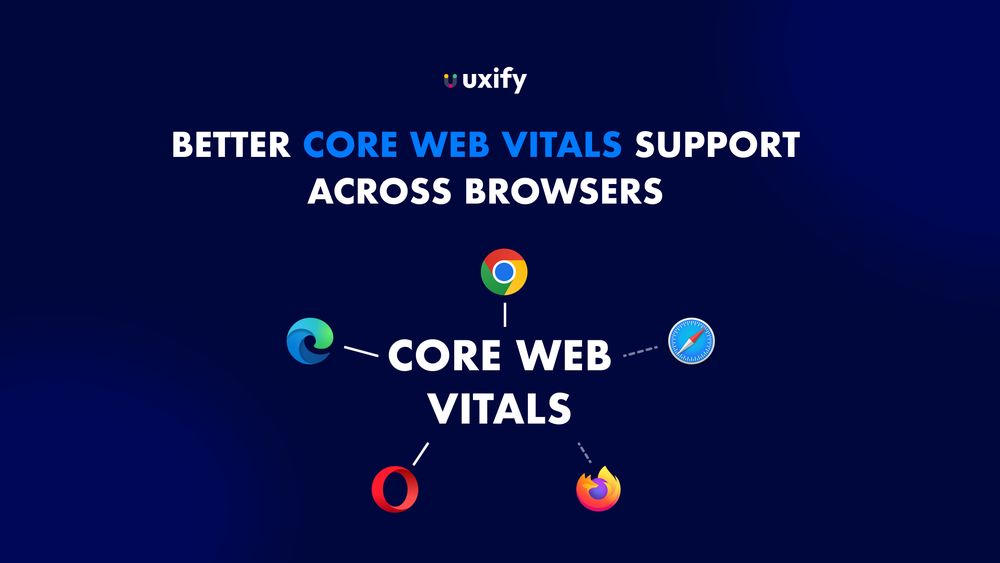
@tunetheweb.com and Tsvetan Stoychev predict that 2025 may bring better Core Web Vitals support across all platforms. It’s an exciting possibility for improving performance consistency for all users. 🌍
#WebPerf #CoreWebVitals #INP #SafariPerformance
21.01.2025 22:18 — 👍 1 🔁 0 💬 1 📌 1

2025 Web Performance Trends: Expert Predictions and Business Takeaways
Discover expert predictions for web performance in 2025, including INP optimization, AI tools, and new browser technologies. Learn how businesses can adapt and thrive with actionable insights and…
4/ Is RUM part of your 2025 strategy?
Dive deeper into 2025 insights and web performance trends: https://buff.ly/40x2r2H
#WebPerformance #RUM #CoreWebVitals #RealUserMonitoring #WebDev #PerformanceOptimization #2025Trends #SyntheticTesting #INP #LCP #PerformanceMetrics
17.01.2025 21:21 — 👍 0 🔁 0 💬 0 📌 0
3/ Next Steps for 2025:
✅ Implement RUM to track real session metrics.
✅ Set alerts to tackle performance dips early.
✅ Optimize journeys with real-world data.
17.01.2025 21:21 — 👍 0 🔁 0 💬 1 📌 0
2/ Key insights:
1️⃣ Synthetic tests provide a snapshot but miss real-world bottlenecks.
2️⃣ RUM tracks how real users experience Core Web Vitals (INP, LCP).
3️⃣ It’s proactive, catching slowdowns before users churn.
17.01.2025 21:21 — 👍 0 🔁 0 💬 1 📌 0
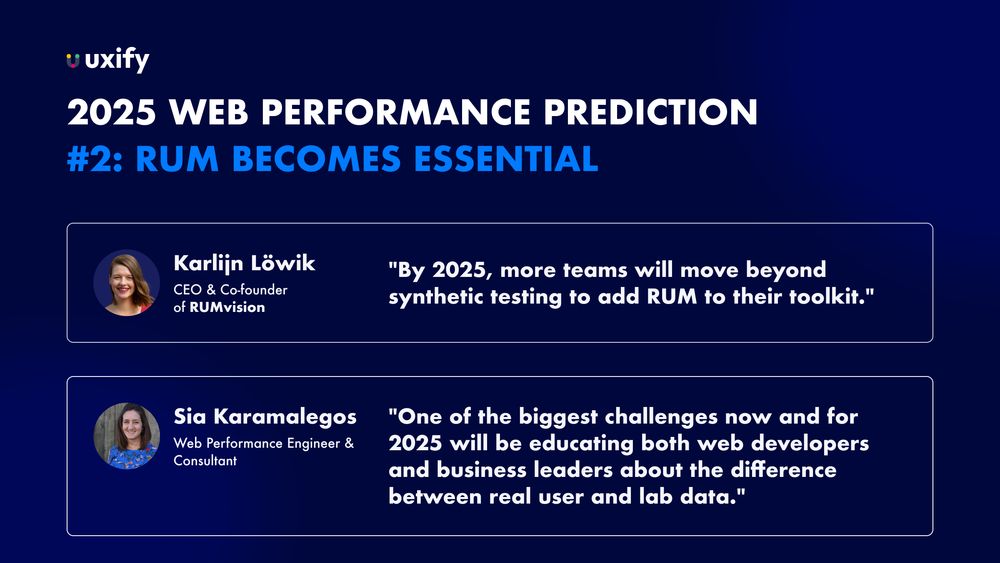
1/ Lab tests ≠ real user experiences.
@SiaKWeb and @KarlijnLowik predict 2025 will be the year RUM becomes the standard for understanding real-world performance. Synthetic tests miss what users feel, RUM doesn’t. 🧵 ⬇️
#WebPerf #RUM #CoreWebVitals
17.01.2025 21:21 — 👍 0 🔁 0 💬 1 📌 0
Making the web more stylish ✨🎨 DevRel Lead for CSS & Web UI @ Google Chrome. Cohost of the CSS Podcast & host of Designing in the Browser. 🌎 una.im
🦖 Your friendly neighborhood vim.dad • Podcaster 🌟 Conference & community builder • 🌽 @nebraskajs.dev Organizer 💻 DX at @workos.bsky.social
Cohost of @syntax.fm
Executive Producer @Sentry.io
Creator of Level Up Tutorials -> now a part of Syntax
Bboy, Denver, Michigan (Go Blue!)
I like to explore and teach web dev topics.
Scaling microservices at Gousto. Built stuff at Fastly and the Financial Times. Web performance matters.
Engineer at Squarespace, web perf nerd, a11y advocate
Staff Web Engineer @AdevintaSpain | Web Performance Consultant | Indie hacker ✨ https://freetourai.com 🌉 http://sobreia.com 🤖 https://perf.reviews ⚡️
#SiteSpeed #WebPerf #WebQuality expert @ CSQ · he/his · also teach · #Opquast FTW · EN/fr · #fedi22
[bridged from https://hachyderm.io/@boostmarks on the fediverse by https://fed.brid.gy/ ]
Worked on @sentry.io for nearly a decade. Co-wrote Third-party JavaScript. Hacking on counterscale.dev in Toronto. 🇨🇦
More: benv.ca
Engineer at @netlify • Speaker • #mozillians member • #webperf enthusiast • Help Ukraine - http://savelife.in.ua/en/donate-en/
TrackJS and Request Metrics | 🍻 PubConf Producer | 💩 JavaScript Happens | Web Performance and Error Debugging | I use Notepad.exe
Minnesota Tech
https://www.toddhgardner.com/
tech echosystem influencer 📣🦋
building a thing 👀
former greentech CTO 🔌🔋 + xoogler 🧢
Web Monkey, Martial Artist, Procrastinator Extraordinaire. Staff Developer @ Shopify, Ex-BBC. Elsewhere: https://x.com/BPScott // http://mastodon.social/@BPScott
i work on things related to web accessibility. i'm probably reviewing your github issue/pr right now. i'll have thoughts.
He/Him - johnmu.com - Skeets my own. Google Search Advocate. For #SEO: g.co/searchcentral . Cheese. Watches. Birds. Spreadsheets.
Do you like cheese? Say hi
Engineering Lead. Community Organizer. Podcast Host.
Long live the web! Engineer on Google Chrome, ex-Opera.
Web Standards Engineer at U+F8FF.







